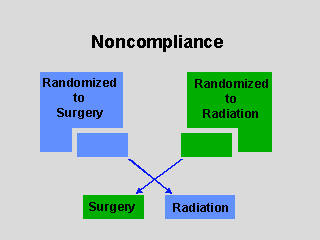|
A commonly encountered complication in many clinical trials is that of
treatment cross-over or noncompliance with assigned treatment. How should
these patients be counted in the data analysis? Should they be discarded?
Should they be included according to the treatment they actually received?
The preferred method of handling treatment cross-overs in such a study is to
analyze the data according to the assigned treatment
("intention to
treat analysis"). The reason for this principle is that crossover to
unassigned treatments is not random. Patients may have varying reasons for
opting for a particular treatment, and if the treatment selection is related
to the study outcome, analysis according to treatment received would yield a
biased estimate of treatment effect. Although the primary analysis always
should be according to "intention to treat", secondary analyses may be
included to evaluate treatment effect in patients receiving the assigned
treatment only. This may be appropriate in trials in which a relatively
large proportion of patients does not receive the assigned treatment.
It is important in all clinical trials to try to minimize noncompliance with
assigned treatments. It is imperative to monitor treatments in order to
estimate the impact of noncompliance.
|
